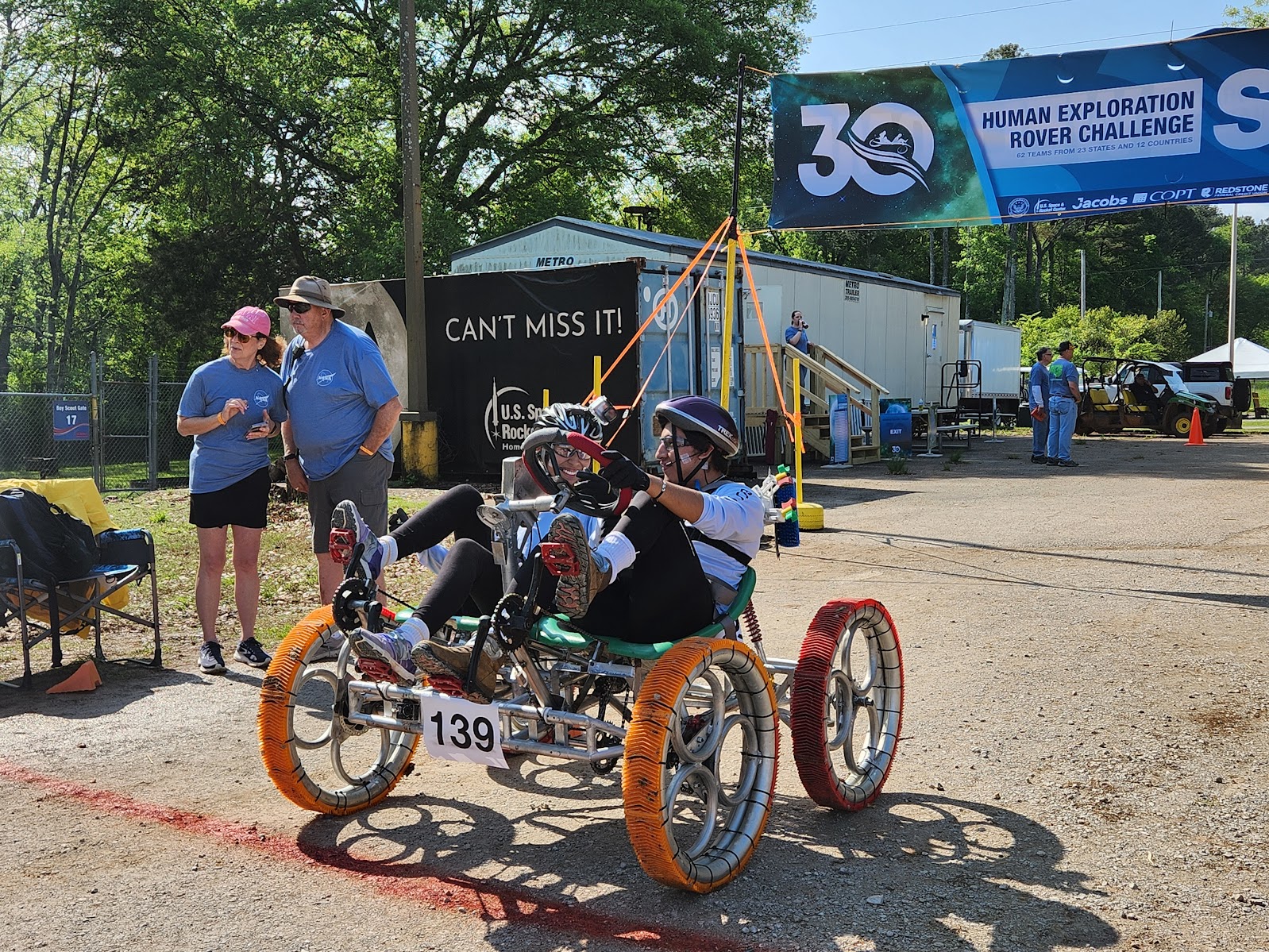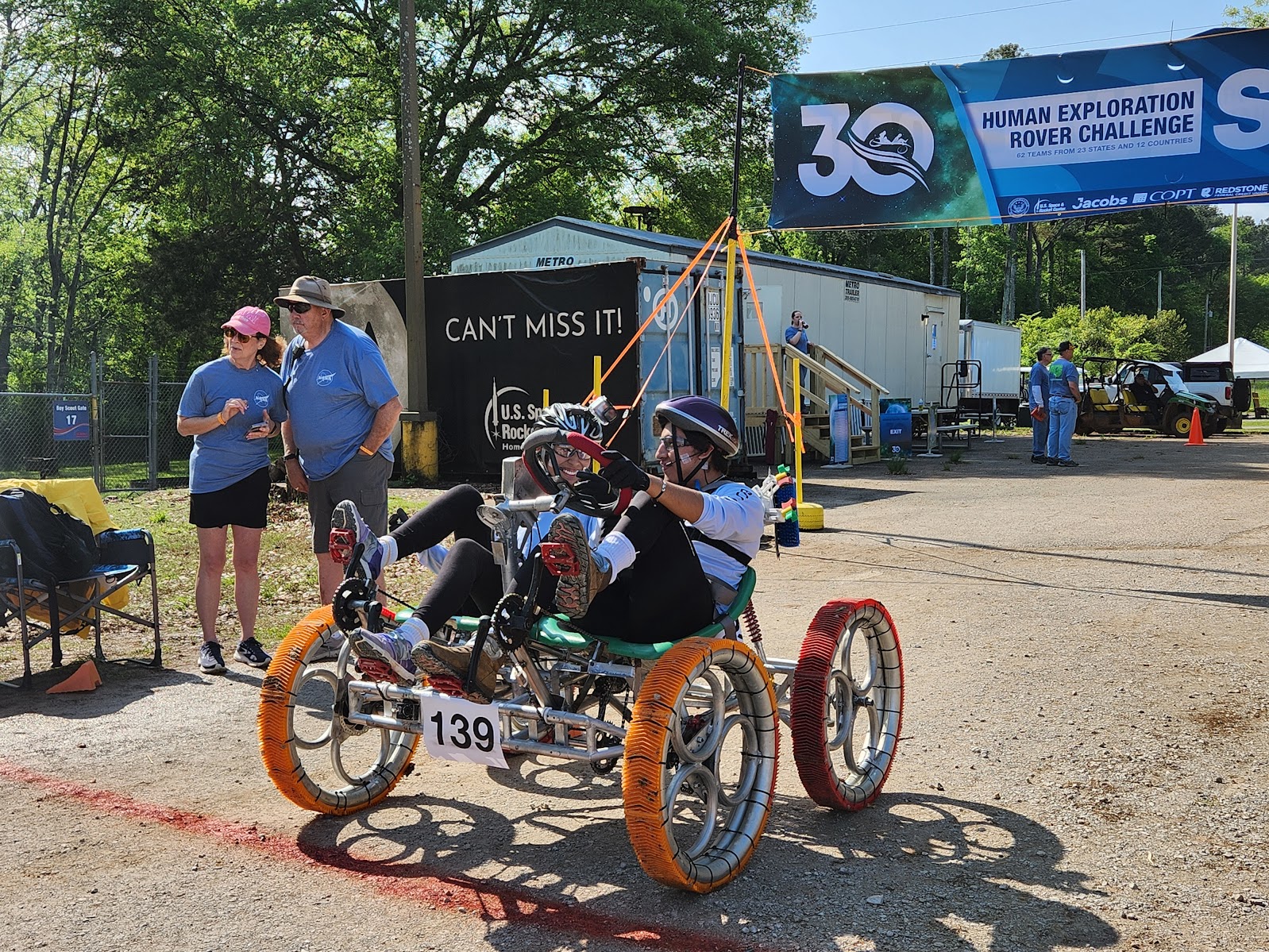29 Min Read The Marshall Star for April 24, 2024 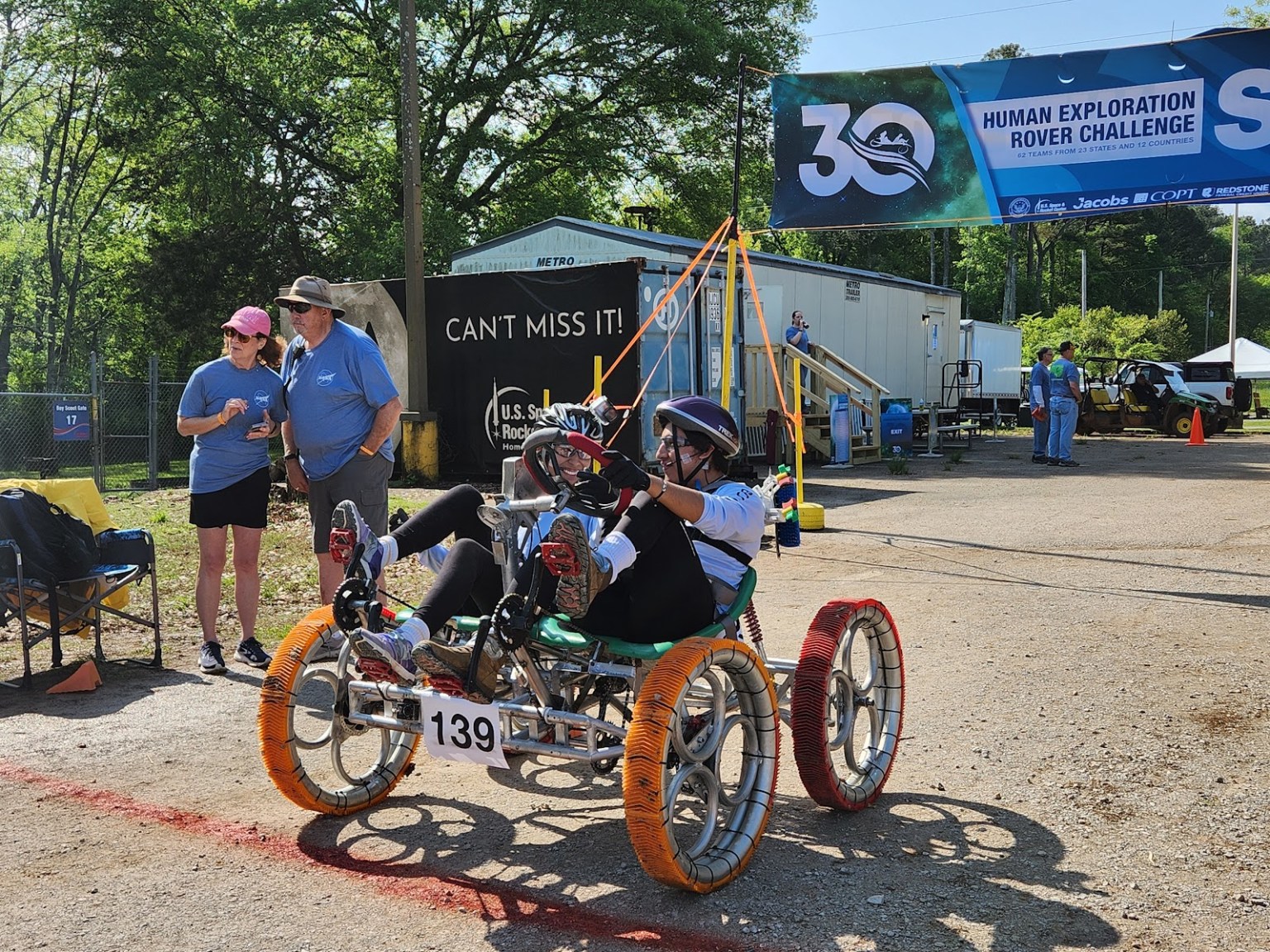 Students from Universidad Católica Boliviana prepare to traverse the course at the 2024 Human Exploration Rover Challenge at the U.S. Space & Rocket Center in Huntsville, Alabama, near NASA’s Marshall Space Flight Center. Credits: Credits: NASA/Taylor Goodwin NASA Announces 30th Human Exploration Rover Challenge Winners NASA announced the winners of the 30th Human Exploration Rover Challenge (HERC) April 22, with Parish Episcopal School, from Dallas, winning first place in the high school division, and the University of Alabama in Huntsville,capturing the college/university title.
Students from Universidad Católica Boliviana prepare to traverse the course at the 2024 Human Exploration Rover Challenge at the U.S. Space & Rocket Center in Huntsville, Alabama, near NASA’s Marshall Space Flight Center. Credits: Credits: NASA/Taylor Goodwin NASA Announces 30th Human Exploration Rover Challenge Winners NASA announced the winners of the 30th Human Exploration Rover Challenge (HERC) April 22, with Parish Episcopal School, from Dallas, winning first place in the high school division, and the University of Alabama in Huntsville,capturing the college/university title.
The annual engineering competition – one of NASA’s longest standing challenges – held its concluding event April 19 and April 20, at the U.S. Space & Rocket Center in Huntsville, near NASA’s Marshall Space Flight Center. The complete list of 2024 award winners is provided below:
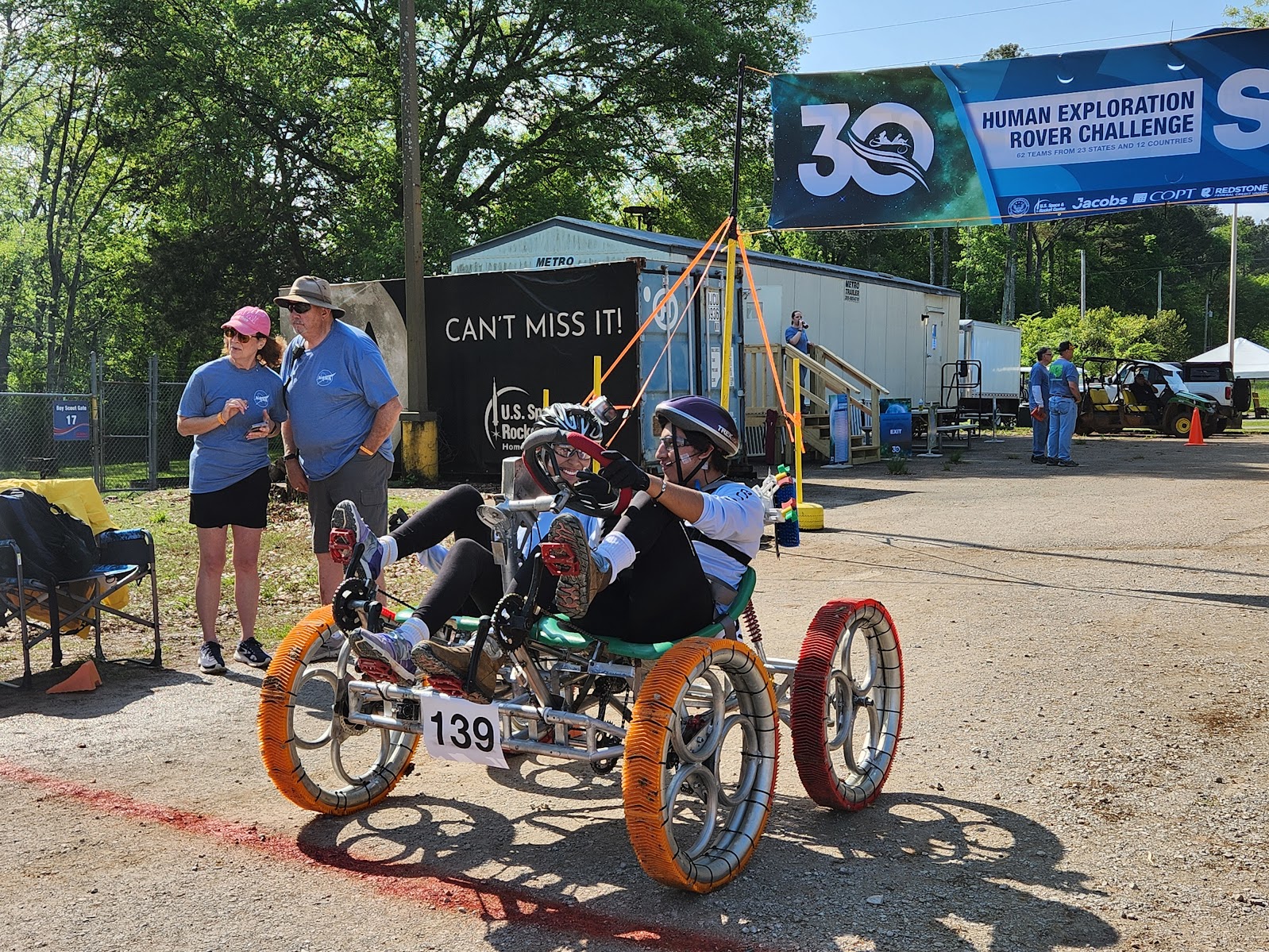 Students from Universidad Católica Boliviana prepare to traverse the course at the 2024 Human Exploration Rover Challenge at the U.S. Space & Rocket Center in Huntsville, near NASA’s Marshall Space Flight Center.Credits: NASA/Taylor Goodwin High School Division
Students from Universidad Católica Boliviana prepare to traverse the course at the 2024 Human Exploration Rover Challenge at the U.S. Space & Rocket Center in Huntsville, near NASA’s Marshall Space Flight Center.Credits: NASA/Taylor Goodwin High School Division
First Place: Parish Episcopal School, Dallas Second Place: Academy of Arts, Careers and Technology, Reno, Nevada Third Place: Escambia High School, Pensacola, Florida College/University Division
First Place: University of Alabama in Huntsville Second Place: Instituto Tecnológico de Santo Domingo, Dominican Republic Third Place: Campbell University, Buies Creek, North Carolina Ingenuity Award
University of West Florida, Pensacola, Florida Phoenix Award
High School Division: East Central High School, Moss Point, Mississippi College/University Division: North Dakota State University, Fargo, North Dakota Task Challenge Award
High School Division: Erie High School, Erie, Colorado College/University Division: South Dakota School of Mines and Technology, Rapid City, South Dakota Project Review Award
High School Division: Parish Episcopal School, Dallas College/University Division: University of Alabama in Huntsville Featherweight Award
Rhode Island School of Design, Providence, Rhode Island Safety Award
High School Division: NPS International School, Singapore College/University Division: Instituto Especializado de Estudios Superiores Loyola, San Cristobal, Dominican Republic Crash and Burn Award
KIET Group of Institutions, Delhi-NCR, India Jeff Norris and Joe Sexton Memorial Pit Crew Award
High School Division: Erie High School, Erie, Colorado College/University Division: Campbell University, Buies Creek, North Carolina Team Spirit Award
Instituto Tecnológico de Santo Domingo, Dominican Republic Most Improved Performance Award
High School Division: Jesco von Puttkamer School, Leipzig, Germany College/University Division: Universidad Católica Boliviana – San Pablo, La Paz, Bolivia Social Media Award
High School Division: Bledsoe County High School, Pikeville, Tennessee College/University Division: Universidad de Piura, Peru STEM Engagement Award
High School Division: Princess Margaret Secondary School, Surrey, British Columbia College/University Division: Trine University, Angola, Indiana Artemis Educator Award
Sadif Safarov from Istanbul Technical University, Turkey Rookie of the Year
Kanakia International School, Mumbai, India More than 600 students with 72 teams from around the world participated as HERC celebrated its 30th anniversary as a NASA competition. Participating teams represented 42 colleges and universities and 30 high schools from 24 states, the District of Columbia, Puerto Rico, and 13 other nations from around the world. Teams were awarded points based on navigating a half-mile obstacle course, conducting mission-specific task challenges, and completing multiple safety and design reviews with NASA engineers.
“This student design challenge encourages the next generation of scientists and engineers to engage in the design process by providing innovative concepts and unique perspectives,” said Vemitra Alexander, HERC activity lead for NASA’s Office of STEM Engagement at Marshall. “While celebrating the 30th anniversary of the challenge, HERC also continues NASA’s legacy of providing valuable experiences to students who may be responsible for planning future space missions including crewed missions to other worlds.”
HERC is one of NASA’s eight Artemis Student Challenges reflecting the goals of the Artemis program, which seeks to land the first woman and first person of color on the Moon while establishing a long-term presence for science and exploration. NASA uses such challenges to encourage students to pursue degrees and careers in the fields of science, technology, engineering, and mathematics.
HERC is managed by NASA’s Southeast Regional Office of STEM Engagement at Marshall. Since its inception in 1994, more than 15,000 students have participated in HERC – with many former students now working at NASA, or within the aerospace industry. Watch a video recap of the competition.
Watch a video recap of the competition.
Take 5 with Julie Clift Edstrom By Wayne Smith
From helping coordinate NASA speaking requests for the total solar eclipse to supporting Student Launch and the Human Exploration Rover Challenge, April has been a busy month for Julie Clift Edstrom. But those activities have also served as a powerful reminder of why she loves her role at the agency’s Marshall Space Flight Center.
 Julie Clift Edstrom is an education specialist supporting Next Gen STEM and Space Grant in NASA’s Southeast Regional Office of STEM Engagement at the agency’s Marshall Space Flight Center, where she leads the Artemis Student Challenges.NASA Edstrom is an education specialist supporting Next Gen STEM and Space Grant in NASA’s Southeast Regional Office of STEM Engagement at Marshall, where she leads the Artemis Student Challenges for middle school, high school, and college students. NASA’s Office of STEM Engagement uses challenges and competitions to further the agency’s goal of encouraging students to pursue degrees and careers in science, technology, engineering, and mathematics. There are eight Artemis Student Challenges, which include BIG Idea, Lunabotics, First Nations Launch, SUITS, Micro-g NExT, App Development Challenge, Human Exploration Rover Challenge, and Student Launch.
Julie Clift Edstrom is an education specialist supporting Next Gen STEM and Space Grant in NASA’s Southeast Regional Office of STEM Engagement at the agency’s Marshall Space Flight Center, where she leads the Artemis Student Challenges.NASA Edstrom is an education specialist supporting Next Gen STEM and Space Grant in NASA’s Southeast Regional Office of STEM Engagement at Marshall, where she leads the Artemis Student Challenges for middle school, high school, and college students. NASA’s Office of STEM Engagement uses challenges and competitions to further the agency’s goal of encouraging students to pursue degrees and careers in science, technology, engineering, and mathematics. There are eight Artemis Student Challenges, which include BIG Idea, Lunabotics, First Nations Launch, SUITS, Micro-g NExT, App Development Challenge, Human Exploration Rover Challenge, and Student Launch.
Edstrom managed the Student Launch competition for 10 years and points to that experience as the proudest of her career, particularly the awards ceremony for the 2015 event Marshall hosted at the U.S. Space & Rocket Center in Huntsville.
“I remember it vividly and it still brings tears to my eyes when I think about it,” said Edstrom, who is from Huntsville. “It was my final year of managing the activity, all the awards had been given, and it was my task to provide closing remarks. As I stood at the podium looking at approximately a thousand people, I was overwhelmed with emotion at the impact this activity had made on so many lives. These students, educators, and mentors had traveled from all over the U.S., had worked so hard, and accomplished so much, and here I stood with the privilege of being able to lead such an activity. How grateful I am to have had that opportunity!”
She also leads a new platform, NASA Engages, an online tool to connect agency experts to community engagements such as the April 8 total solar eclipse event in Russellville, Arkansas. The NASA Engages tool is composed of agency civil servants and contractors who share NASA missions and content at educational, professional, civic, and other public venues.
Question: What excites you most about the future of human space exploration, or your NASA work, and your team’s role in it?
Edstrom: Our job in the Office of STEM Engagement is directly tied to the future of human space exploration through leading the next generation into our workforce. I can’t tell you the number of students I’ve worked with who are “wow’d” by NASA, have participated in one of our challenges, and/or that I’ve hired through the Pathways program who are now working among us and making a daily impact on space exploration. It’s fun to watch their growth and journey.
Question: Who or what drives/motivates you?
Edstrom: There’s certainly a theme here, but it is easy to forget when we are sitting at a computer or participating in meetings. I’ve supported NASA for 21 years thus far, seven as a contractor and 14 as a co-op turned civil servant. My role has been primarily in the areas of education and human resources. The people I serve drives my motivation. Whether it’s helping someone set up their profile in NASA Engages, talking to students about opportunities, or conducting classroom demonstrations, my goal is and has always been to help others achieve their desires. In my newest position, I’ve been able to watch the NASA Engages tool reach close to 19,000 people in less than four months, many of them students.
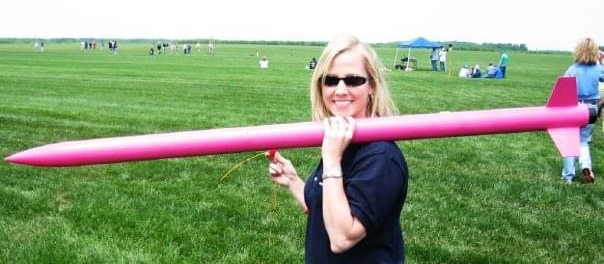 Edstrom displays her rocket at the Student Launch competition in 2006, where she earned a Level 1 certification. “Leading Student Launch, I wanted to learn what the student teams were doing as part of the challenge,” she said. “My rocket was nowhere near as sophisticated as theirs, but at least I got the basics.”Photo courtesy of Julie Clift Edstrom Question: Who or what inspired you to pursue an education/career that led you to NASA and Marshall?
Edstrom displays her rocket at the Student Launch competition in 2006, where she earned a Level 1 certification. “Leading Student Launch, I wanted to learn what the student teams were doing as part of the challenge,” she said. “My rocket was nowhere near as sophisticated as theirs, but at least I got the basics.”Photo courtesy of Julie Clift Edstrom Question: Who or what inspired you to pursue an education/career that led you to NASA and Marshall?
Edstrom: I ask this question of our NASA experts in NASA Engages and I always share my story as well. When I was infifth grade, I despised those timed multiplication quizzes where you needed to answer 100 questions in one minute. I was horrible at it and remember making a 30 on one test. In sixth grade, Mrs. Kathleen Williams changed that path for me. Later in high school, my art teacher, Mrs. Melissa Hughey, suggested I become a teacher. Therefore, I was a fifth grade math teacher for six years before coming to NASA and am proud to say at least one of my former students works at Marshall.
Question: What advice do you have for employees early in their NASA career or those in new leadership roles?
Edstrom: The biggest piece of advice is to build and maintain relationships. Secondly, stay curious and eager to learn, broaden your skills whenever possible, and find ways to give of your time even when it’s not required. Finally, try to make someone’s day a little better. It could be simple eye contact and a smile.
Question: What do you enjoy doing with your time while away from work?
Edstrom: I absolutely love seeing the world. Most of the time, I see it from a cruise ship! I also just got married for the first time three years ago, so spending time with my family is definitely important to me.
Smith, a Media Fusion employee and the Marshall Star editor, supports the Marshall Office of Communications.
Student Launch Challenge Highlighted on ‘This Week at NASA’ NASA’s 2024 Student Launch challenge brought students from colleges, universities, high schools, middle schools, and informal education groups to launch amateur rockets and payloads April 13 near NASA’s Marshall Space Flight Center. The challenge is featured in “This Week @ NASA,” a weekly video program broadcast on NASA-TV and posted online.
Student Launch provides relevant, cost-effective research and development of rocket propulsion systems and reflects the goals of NASA’s Artemis campaign, which seeks to put the first woman and first person of color on the Moon.
Winners of the student launch will be announced June 7 during a virtual awards ceremony once all teams’ flight data has been verified.
Marshall’s Office of STEM Engagement hosts Student Launch to encourage students to pursue careers in STEM through real-world experiences. Student Launch is a part of the agency’s Artemis Student Challenges – a variety of activities exposing students to the knowledge and technology required to achieve the goals of the Artemis missions.
View this and previous episodes at “This Week @NASA” on NASA’s YouTube page.
Marshall Research Scientist Enables Large-Scale Open Science By Jessica Barnett
Most people use tools at work, whether it’s a hammer, a pencil, or a computer. Very few seek a doctorate degree in creating new tools for the job.
Using that degree to make it easier for people around the world to access and use the vast amounts of data gathered by NASA? Well, that might just be unheard of if you didn’t know someone like Rahul Ramachandran, a senior research scientist in the Earth Science branch at NASA’s Marshall Space Flight Center.
 Rahul Ramachandran is a senior research scientist at NASA’s Marshall Space Flight Center.NASA “My undergrad was in mechanical engineering. I wanted to do industrial engineering, so I came to the U.S. for that, but I didn’t like the field that much,” Ramachandran explained. “It was by chance somebody suggested meteorology.”
Rahul Ramachandran is a senior research scientist at NASA’s Marshall Space Flight Center.NASA “My undergrad was in mechanical engineering. I wanted to do industrial engineering, so I came to the U.S. for that, but I didn’t like the field that much,” Ramachandran explained. “It was by chance somebody suggested meteorology.”
That led him to learn about atmospheric science as well, but it was the 1990s and the technology of the time was very limiting. So, Ramachandran set out to learn more about computers and how to better analyze data.
“The limitations effectively prompted me to get a degree in computer science,” he said. “I now had science, engineering, and computer science in my background. Then, over the years, I got more and more interested in the tools and capabilities that can help not only manage data but also how you extract knowledge from these large datasets.”
Fast forward to today, and Ramachandran is an award-winning scientist helping to ensure the vast amounts of data collected by NASA are accessible and searchable for scientists around the world.
“I never would have thought that I could ever get a job working at an agency like NASA,” he said. “You get to work with some of the smartest people in the world, and you get to work on really hard problems. I think that’s what makes it so intellectually stimulating.”
Over the course of his career, he has worked on many different projects focused on scientific data management, designed frameworks for large scale scientific analysis, and developed machine learning applications. Recently, he worked with team members at IBM Research to create a geospatial AI foundation model that could turn NASA satellite data into maps of natural disasters or other environmental changes. He also established the Interagency Implementation and Advanced Concepts Team (IMPACT) at NASA, which supports NASA’s Earth Science Data Systems Program by collaborating with other agencies and partners to boost the scientific benefits of data collected by NASA’s missions and experiments.
Ramachandran received the 2023 Greg Leptoukh Lecture award for his accomplishments, an honor he attributes in large part to the many collaborators and mentors he’s had over the years.
During his presentation, Ramachandran spoke about the ways in which artificial intelligence can help NASA continue to adapt and support open science.
“We’ve seen what people can do with ChatGPT, which is built on a language foundation model, but there are AI foundation models for science that can be adapted into analyzing scientific data so we can augment what we are doing now in a much more efficient manner,” he said. “It requires a bit of a change in people’s mindset. How do we rethink our processes? How do we rethink a strategy for managing data? How will people search and analyze data information differently? All those things have to be thought of with a different perspective now.”
Such work will have benefits not only for NASA but for those who use the data collected by the agency. Ramachandran said he recently got an email from someone in Africa who was able to use NASA’s data and the geospatial AI foundation model for detecting locust breeding grounds on the continent.
“NASA has produced valuable science data that we make available to the community to use,” Ramachandran said. “I think the future would be that we not only provide the data, but we also provide these AI models that allow the science community to use the data effectively, whether it’s doing basic research or building applications like the locust breeding ground prediction.”
As that future nears, Ramachandran and his team will be ready to help others in the science community find the data they need to learn and build the tools they’ll use for years to come.
Barnett, a Media Fusion employee, supports the Marshall Office of Communications.
PMPO Team Members Discuss NASA Science Missions at Huntsville Comic & Pop Culture Expo Team Members from NASA Marshall Space Flight Center’s Planetary Mission Program Office (PMPO) participated in a panel discussion April 13 at the Huntsville Comic & Pop Culture Expo at the Von Braun Center in Huntsville.
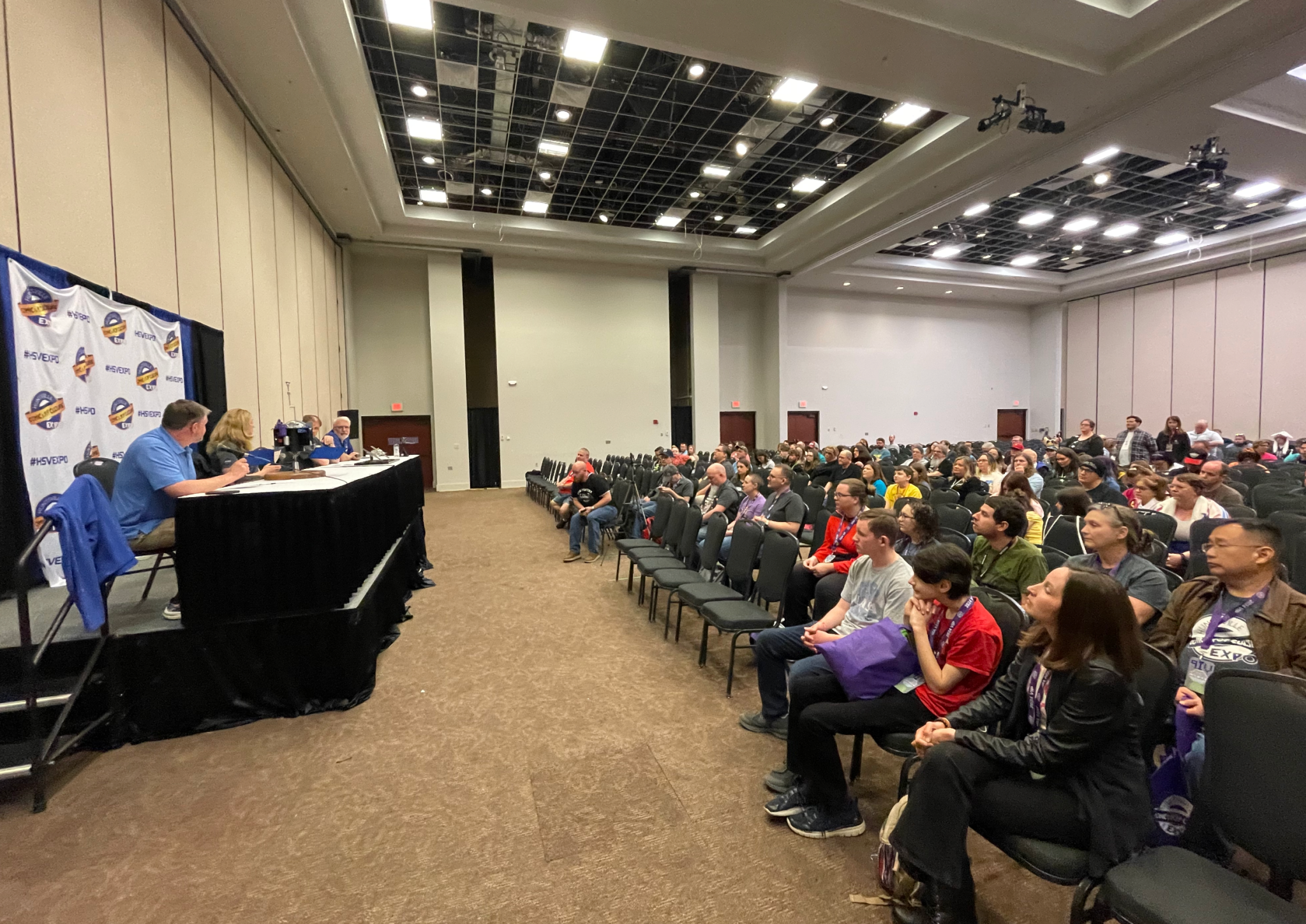 Members of NASA Marshall Space Flight Center’s Planetary Mission Program Office participate in a panel April 13 at the Huntsville Comic & Pop Culture Expo at the Von Braun Center in Huntsville. NASA/Daniel Horton Approximately 150 people attended the panel, which featured PMPO team members talking about the different missions they manage at NASA.
Members of NASA Marshall Space Flight Center’s Planetary Mission Program Office participate in a panel April 13 at the Huntsville Comic & Pop Culture Expo at the Von Braun Center in Huntsville. NASA/Daniel Horton Approximately 150 people attended the panel, which featured PMPO team members talking about the different missions they manage at NASA.
“I was really encouraged by the turnout and the enthusiasm of the crowd,” said Brian Mulac, deputy manager of the Planetary Missions Program Office. “They asked some great questions and it was a good opportunity to highlight some of our exciting missions to the community.”
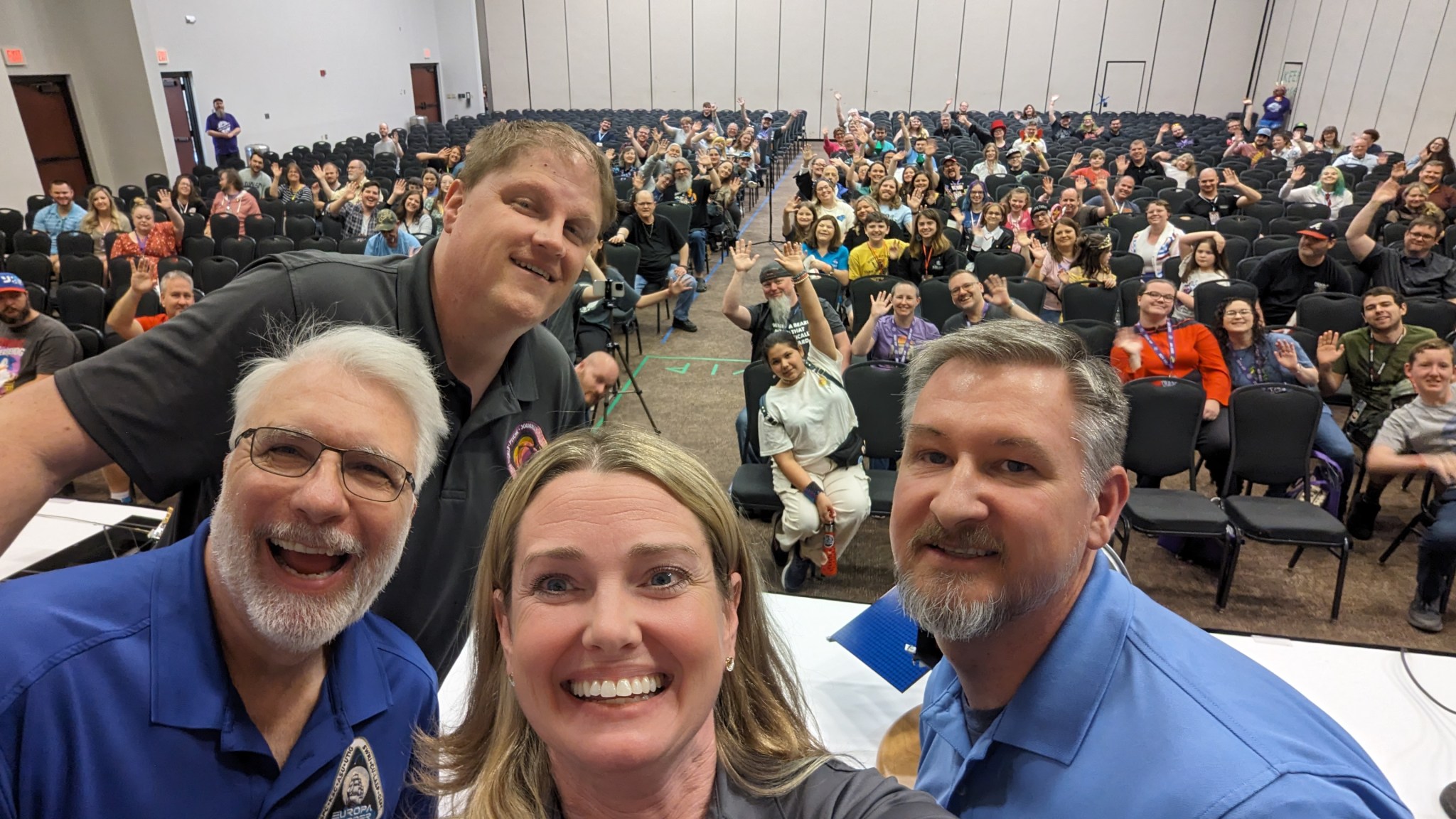 From left, Scott Bellamy, Brad Zavodsky, Solveig Irvine, and Brian Mulac pose for a selfie after speaking during a NASA science panel at the Huntsville Comic & Pop Culture Expo on April 13. The group discussed the upcoming science missions managed by the Planetary Missions Program Office. NASA/Solveig Irvine Mission Manager Solveig Irvine agreed. “I loved being able to share the excitement of sample return with the local community,” Irvine said. “Living and working in Huntsville we all feel a special bond with our local science community, and being able to sit and talk with the local audience about our missions was an amazing experience.”
From left, Scott Bellamy, Brad Zavodsky, Solveig Irvine, and Brian Mulac pose for a selfie after speaking during a NASA science panel at the Huntsville Comic & Pop Culture Expo on April 13. The group discussed the upcoming science missions managed by the Planetary Missions Program Office. NASA/Solveig Irvine Mission Manager Solveig Irvine agreed. “I loved being able to share the excitement of sample return with the local community,” Irvine said. “Living and working in Huntsville we all feel a special bond with our local science community, and being able to sit and talk with the local audience about our missions was an amazing experience.”
Mission Success is in Our Hands: Matthew Pruitt By Wayne Smith
Mission Success is in Our Hands is a safety initiative collaboration between NASA’s Marshall Space Flight Center and Jacobs. As part of the initiative, eight Marshall team members are featured in testimonial banners placed around the center. This is the sixth in a Marshall Star series profiling team members featured in the testimonial banners. The Mission Success team also awards the Golden Eagle Award on a quarterly basis to Marshall and contractor personnel who are nominated by their peers or management. Candidates for this award have made significant, identifiable contributions that exceed normal job expectations to advance flight safety and mission assurance. Nominations are open now to team members on Inside Marshall.
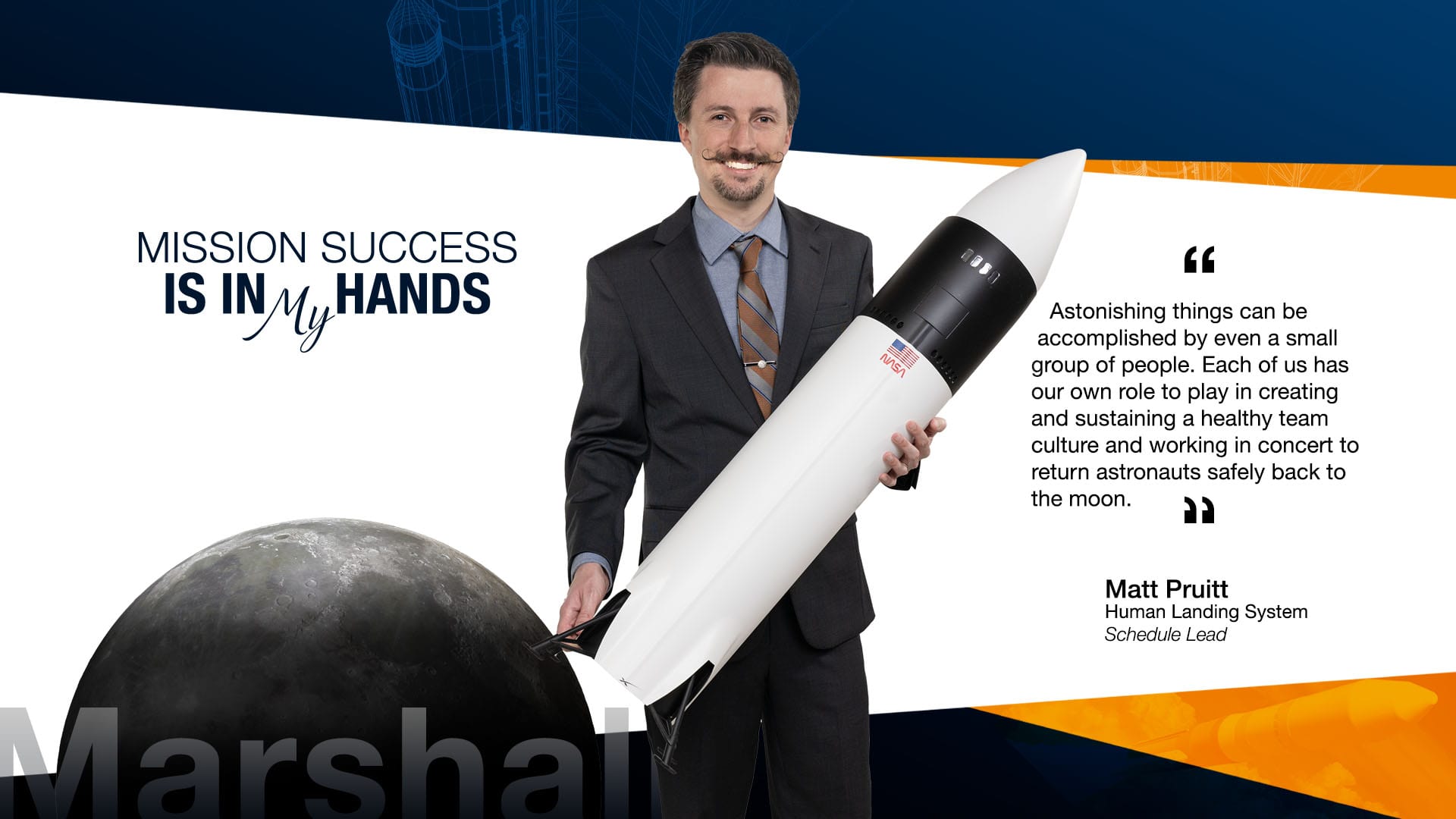 Matthew Pruitt is the schedule functional lead for NASA’s Human Landing System Program. NASA/Charles Beason Matthew Pruitt is the schedule functional lead for the Human Landing System (HLS) Program at NASA’s Marshall Space Flight Center. His key responsibilities include leading the HLS Schedule team in weaving together many schedule threads from contractor and government teams into one cogent story and communicating that story within HLS, to peer programs, and to the Moon to Mars enterprise.
Matthew Pruitt is the schedule functional lead for NASA’s Human Landing System Program. NASA/Charles Beason Matthew Pruitt is the schedule functional lead for the Human Landing System (HLS) Program at NASA’s Marshall Space Flight Center. His key responsibilities include leading the HLS Schedule team in weaving together many schedule threads from contractor and government teams into one cogent story and communicating that story within HLS, to peer programs, and to the Moon to Mars enterprise.
Pruitt has worked at Marshall for 15 years, including three years as a co-op student. He’s also been a test engineer for life support systems, manufacturing engineer for the Marshall machine shop, design engineer, and most recently lead systems engineer for the Near Earth Asteroid Scout mission.
A native of Huntsville, Pruitt earned his bachelor’s degree in mechanical engineering from Auburn University.
Question: How does your work support the safety and success of NASA and Marshall missions?
Pruitt: My team’s work supports mission safety and success by making sure the hundreds of different efforts required to place crew safely back on the Moon work in concert, both within HLS and between us and the other programs of the Artemis campaign. The clearest example of this is our safety reviews: in partnership with HLS Safety and Mission Assurance, we help ensure that our data product readiness supports our safety review schedules, ultimately leading to a certified vehicle.
Question: Our initiative campaign is “Mission Success is in Our Hands.” What does that mean to you?
Pruitt: To me, “Mission Success is in Our Hands” means that each of us at NASA has our own role to play in ensuring the agency accomplishes its mission. Our commitment and diligence as a workforce are what power our achievements – and many hands make light work!
Question: Do you have a story or personal experience you can share that might help others understand the significance of mission assurance or flight safety? What did you learn from it?
Pruitt: During Near Earth Asteroid (NEA) Scout’s integrated spacecraft environmental testing, our team needed to transport the spacecraft from our assembly facility to one of the test labs. To shorten setup time at the test lab, we modified our procedure to allow installation of a cable on the spacecraft prior to transport, rather than after arrival at the test lab. While this change was reviewed by the appropriate parties, our documentation ultimately proved insufficient to catch a risk to the spacecraft from transporting it in this way. A component on the spacecraft was damaged as a result, and the project lost over a month devising and implementing software updates to circumvent the damage.
The event and its aftermath taught me two things. First, it reinforced for me the importance of our test review process. In several instances earlier in my career, I found myself reflecting on the tedium of test reviews – but the value of ensuring everyone on the team has the complete picture of what is being done during a test cannot be overstated. You never know whose insights might save the project time or cost in preventing a mishap.
Second, it taught me that with a determined, collaborative team, anything is possible. We conceived a new method of operating the spacecraft, captured the changes in a software update, tested and deployed the update, replanned the subsequent environmental test to accommodate the new operating method, and executed the test, all in the span of two months. It was a herculean effort, shouldered by a team that believed in the mission and wanted it to succeed.
Question: How can we work together better to achieve mission success?
Pruitt: Mission success is best achieved with a healthy team; astonishing things can be accomplished by even a small group of people, if the right practices are in place. I’ve found the most important are to respect your fellow teammates, value their contributions, and listen to what they have to say. While those practices must start with team leadership, all members have a share in creating and sustaining the right team environment.
Question: Do you have anything else you’d like to share?
Pruitt: I traveled with my family to see the April 8 total solar eclipse in Russellville, Arkansas, and that experience reminded me anew of why NASA is so important. Our agency has the fundamental role of bringing the wonder and beauty of the cosmos to the public. Seeing that firsthand deepened my resolve to help deliver on all of NASA’s inspiring goals, from returning crew to the Moon, or returning samples from Mars, to deepening our understanding of our universe. I couldn’t be prouder to work at this agency.
Smith, a Media Fusion employee and the Marshall Star editor, supports the Marshall Office of Communications.
AI for Earth: How NASA’s Artificial Intelligence and Open Science Efforts Combat Climate Change As extreme weather events increase around the world due to climate change, the need for further research into our warming planet has increased as well. For NASA, climate research involves not only conducting studies of these events, but also empowering outside researchers to do the same. The artificial intelligence (AI) efforts spearheaded by the agency offer a powerful tool to accomplish these goals.
In 2023, NASA teamed up with IBM Research to create an AI geospatial foundation model. Trained on vast amounts of NASA’s widely used Harmonized Landsat and Sentinel-2 data, the model provides a base for a variety of AI-powered studies to tackle environmental challenges. In keeping with open science principles, the foundation model is freely available for anyone to access.
 Lights brighten the night sky in this image of Europe, including Poland, taken from the International Space Station.NASA Foundation models serve as a baseline from which scientists can develop a diverse set of applications, enabling powerful and efficient solutions. “Foundation models only know what things are represented in the data,” explained Manil Maskey, the data science lead at NASA’s Office of the Chief Science Data Officer. “It’s like a Swiss Army Knife – it can be used for multiple different things.”
Lights brighten the night sky in this image of Europe, including Poland, taken from the International Space Station.NASA Foundation models serve as a baseline from which scientists can develop a diverse set of applications, enabling powerful and efficient solutions. “Foundation models only know what things are represented in the data,” explained Manil Maskey, the data science lead at NASA’s Office of the Chief Science Data Officer. “It’s like a Swiss Army Knife – it can be used for multiple different things.”
Once a foundation model is created, it can be trained on a small amount of data to perform a specific task. To date, the Interagency Implementation and Advanced Concept Team (IMPACT) along with collaborators have demonstrated the geospatial foundation model’s capabilities by fine-tuning it to detect burn scars, to delineate flood water, and to classify crop and other land use categories.
Maskey is the senior research scientist and project manager for the IMPACT project in the Earth Science branch at NASA’s Marshall Space Flight Center.
Because of the computational resources required to create the initial foundation model, a partnership was necessary for success. In this case, NASA brought the data and scientific knowledge, while IBM brought the computing power and AI algorithm optimization expertise. The team’s shared commitment to making their research accessible through open science principles ensures that their model can be useful to as many researchers as possible.
“To build a foundation model at scale, we realized early on that it’s not feasible for one institution to build it,” Maskey said. “Everything we have done on our foundation models has been open to the public, all the way from pre-training data, code, best practices, model weights, fine-tuning training data, and publications. There’s transparency, so researchers can trace why certain things were used in terms of data or model architecture.”
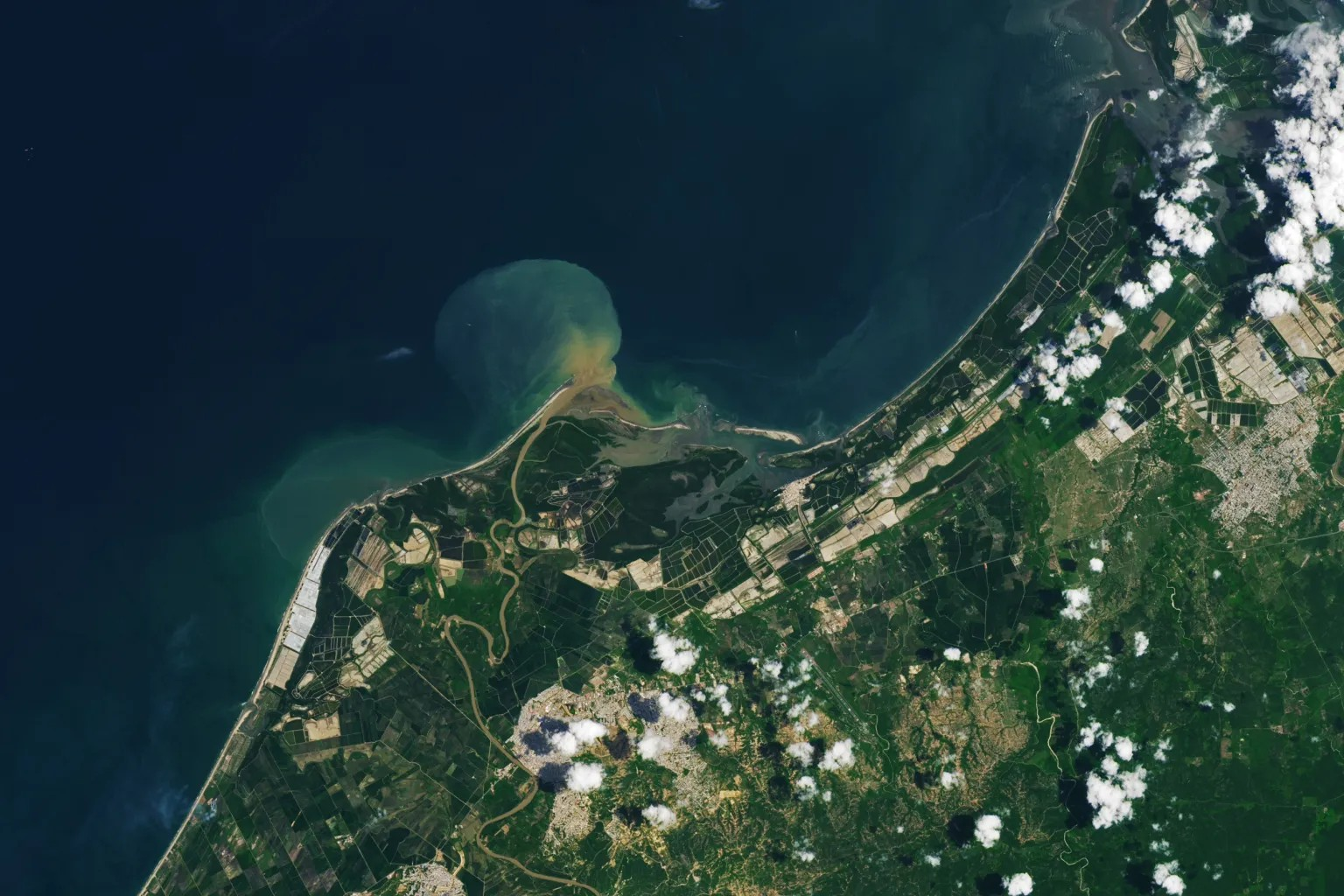 Rectangular ponds for shrimp farming line the coast of northern Peru in this image captured on March 14, 2024, by the OLI-2 (Operational Land Imager-2) on Landsat 9. NASA Earth Observatory/Lauren Dauphin Following on from the success of their geospatial foundation model, NASA and IBM Research are continuing their partnership to create a new, similar model for weather and climate studies. They are collaborating with Oak Ridge National Laboratory (ORNL), NVIDIA, and several universities to bring this model to life.
Rectangular ponds for shrimp farming line the coast of northern Peru in this image captured on March 14, 2024, by the OLI-2 (Operational Land Imager-2) on Landsat 9. NASA Earth Observatory/Lauren Dauphin Following on from the success of their geospatial foundation model, NASA and IBM Research are continuing their partnership to create a new, similar model for weather and climate studies. They are collaborating with Oak Ridge National Laboratory (ORNL), NVIDIA, and several universities to bring this model to life.
This time, the main dataset will be the Modern-Era Retrospective analysis for Research and Applications, Version 2 (MERRA-2), a huge collection of atmospheric reanalysis data that spans from 1980 to the present day. Like the geospatial foundation model, the weather and climate model is being developed with an open science approach, and will be available to the public in the near future.
Covering all aspects of Earth science would take several foundation models trained on different types of datasets. However, Maskey believes those future models might someday be combined into one comprehensive model, leading to a “digital twin” of the Earth that would provide unparalleled analysis and predictions for all kinds of climate and environmental events.
Whatever innovations the future holds, NASA and IBM’s geospatial and climate foundation models will enable leaps in Earth science like never before. Though powerful AI tools will enhance researchers’ work, the team’s dedication to open science supercharges the possibilities for discovery by allowing anyone to put those tools into practice and pave the way for groundbreaking research to help better care for the planet.
Read more about open science at NASA.
Work Underway on Large Cargo Landers for NASA’s Artemis Moon Missions Under NASA’s Artemis campaign, the agency and its partners will send large pieces of equipment to the lunar surface to enable long-term scientific exploration of the Moon for the benefit of all. NASA’s human landing system providers, SpaceX and Blue Origin, are beginning development of lunar landers for large cargo deliveries to support these needs.
 Early conceptual renderings of cargo variants of human lunar landing systems from NASA’s providers SpaceX, left, and Blue Origin, right. Both industry teams have been given authority to begin design work to provide large cargo landers capable of delivering up to 15 metric tons of cargo, such as a pressurized rover, to the Moon’s surface.SpaceX and Blue Origin NASA has contracted SpaceX and Blue Origin to provide landing systems to take astronauts to the Moon’s surface from lunar orbit, beginning with Artemis III. The agency has asked the two companies to develop cargo versions of their human lunar landers as an option under their existing contracts. These cargo variants are expected to land approximately 26,000 – 33,000 pounds of payload on the lunar surface and be in service no earlier than the Artemis VII mission.
Early conceptual renderings of cargo variants of human lunar landing systems from NASA’s providers SpaceX, left, and Blue Origin, right. Both industry teams have been given authority to begin design work to provide large cargo landers capable of delivering up to 15 metric tons of cargo, such as a pressurized rover, to the Moon’s surface.SpaceX and Blue Origin NASA has contracted SpaceX and Blue Origin to provide landing systems to take astronauts to the Moon’s surface from lunar orbit, beginning with Artemis III. The agency has asked the two companies to develop cargo versions of their human lunar landers as an option under their existing contracts. These cargo variants are expected to land approximately 26,000 – 33,000 pounds of payload on the lunar surface and be in service no earlier than the Artemis VII mission.
“It’s essential that NASA has the capability to land not just astronauts, but large pieces of equipment, such as pressurized rovers, on the Moon for maximum return on science and exploration activities,” said Lisa Watson-Morgan, Human Landing System Program manager at NASA’s Marshall Space Flight Center. “Beginning this work now allows SpaceX and Blue Origin to leverage their respective human lander designs to provide cargo variants that NASA will need in the future.”
NASA expects the cargo versions of the companies’ landers to be modified versions of the human landing systems currently being developed for Artemis III, IV, and V. Modifications will include adjustments for payload interfaces and deployment mechanisms, and the cargo variants will not have human life support systems.
This initial work allows the companies to proceed with development for their cargo landers through a preliminary design review, the step that establishes the basis for proceeding with detailed design. SpaceX is conducting its work under the NextSTEP Appendix H contract, and Blue Origin is conducting its work under NextSTEP Appendix P. NASA officially exercised the options under those contracts in November 2023 to begin work on the large cargo landers.
With Artemis, NASA will explore more of the Moon than ever before, learn how to live and work away from home, and prepare for future human missions to the Red Planet. Artemis requires the best of international space agencies, private industry, and academia to establish the infrastructure for long-term scientific research and exploration. NASA’s SLS (Space Launch System) rocket, exploration ground systems, and Orion spacecraft, along with the human landing system, next-generation spacesuits and rovers, and Gateway lunar space station are the agency’s foundation for human exploration deep space.
Juno Gives Aerial Views of Mountain, Lava Lake on Io Scientists on NASA’s Juno mission to Jupiter have transformed data collected during two recent flybys of Io into animations that highlight two of the Jovian moon’s most dramatic features: a mountain and an almost glass-smooth lake of cooling lava. Other recent science results from the solar-powered spacecraft include updates on Jupiter’s polar cyclones and water abundance.
The new findings were announced April 16 by Juno’s principal investigator Scott Bolton during a news conference at the European Geophysical Union General Assembly in Vienna.
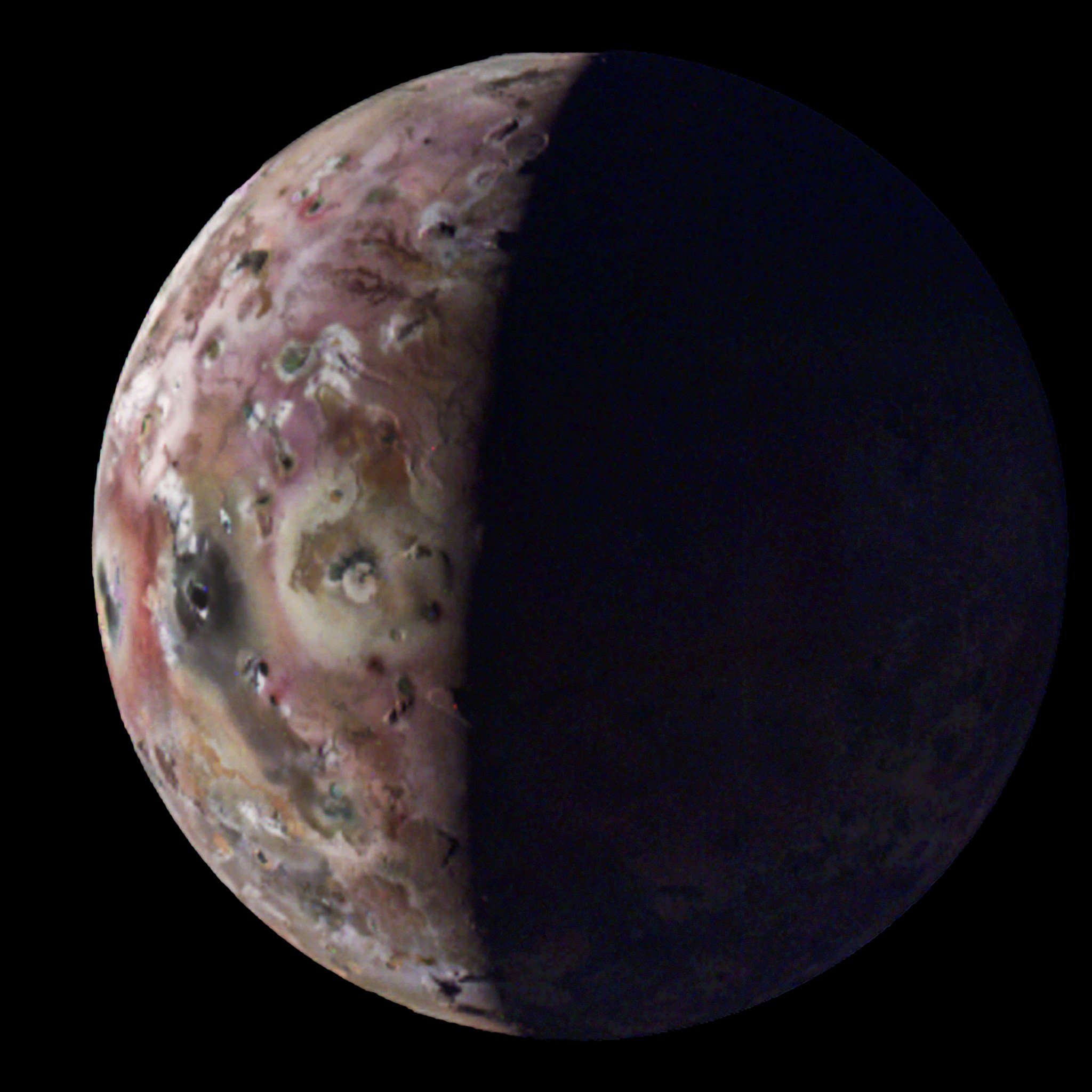 The JunoCam instrument on NASA’s Juno captured this view of Jupiter’s moon Io – with the first-ever image of its south polar region during the spacecraft’s 60th flyby of Jupiter on April 9. (Image credit: NASA/JPL-Caltech/SwRI/MSSS. Image processing: Gerald Eichstädt/Thomas ThomopoulosImage credit: NASA/JPL-Caltech/SwRI/MSSS. Image processing: Gerald Eichstädt/Thomas Thomopoulos (CC BY). Juno made extremely close flybys of Io in December 2023 and February 2024, getting within about 930 miles of the surface, obtaining the first close-up images of the moon’s northern latitudes.
The JunoCam instrument on NASA’s Juno captured this view of Jupiter’s moon Io – with the first-ever image of its south polar region during the spacecraft’s 60th flyby of Jupiter on April 9. (Image credit: NASA/JPL-Caltech/SwRI/MSSS. Image processing: Gerald Eichstädt/Thomas ThomopoulosImage credit: NASA/JPL-Caltech/SwRI/MSSS. Image processing: Gerald Eichstädt/Thomas Thomopoulos (CC BY). Juno made extremely close flybys of Io in December 2023 and February 2024, getting within about 930 miles of the surface, obtaining the first close-up images of the moon’s northern latitudes.
“Io is simply littered with volcanoes, and we caught a few of them in action,” said Bolton. “We also got some great close-ups and other data on a 200-kilometer-long (127-mile-long) lava lake called Loki Patera. There is amazing detail showing these crazy islands embedded in the middle of a potentially magma lake rimmed with hot lava. The specular reflection our instruments recorded of the lake suggests parts of Io’s surface are as smooth as glass, reminiscent of volcanically created obsidian glass on Earth.”
Maps generated with data collected by Juno’s Microwave Radiometer (MWR) instrument reveal Io not only has a surface that is relatively smooth compared to Jupiter’s other Galilean moons, but also has poles that are colder than middle latitudes.
During Juno’s extended mission, the spacecraft flies closer to the north pole of Jupiter with each pass. This changing orientation allows the MWR instrument to improve its resolution of Jupiter’s northern polar cyclones. The data allows multiwavelength comparisons of the poles, revealing that not all polar cyclones are created equal.
“Perhaps most striking example of this disparity can be found with the central cyclone at Jupiter’s north pole,” said Steve Levin, Juno’s project scientist at NASA’s Jet Propulsion Laboratory. “It is clearly visible in both infrared and visible light images, but its microwave signature is nowhere near as strong as other nearby storms. This tells us that its subsurface structure must be very different from these other cyclones. The MWR team continues to collect more and better microwave data with every orbit, so we anticipate developing a more detailed 3D map of these intriguing polar storms.”
One of the mission’s primary science goals is to collect data that could help scientists better understand Jupiter’s water abundance. To do this, the Juno science team isn’t hunting for liquid water. Instead, they are looking to quantify the presence of oxygen and hydrogen molecules (the molecules that make up water) in Jupiter’s atmosphere. An accurate estimate is critical to piecing together the puzzle of our solar system’s formation.
Created using data collected by the JunoCam imager aboard NASA’s Juno during flybys in December 2023 and February 2024, this animation is an artist’s concept of a feature on the Jovian moon Io that the mission science team nicknamed Steeple Mountain. Credit: NASA/JPL-Caltech/SwRI/MSSS Jupiter was likely the first planet to form, and it contains most of the gas and dust that wasn’t incorporated into the Sun. Water abundance also has important implications for the gas giant’s meteorology (including how wind currents flow on Jupiter) and internal structure.
In 1995, NASA’s Galileo probe provided an early dataset on Jupiter’s water abundance during the spacecraft’s 57-minute descent into the Jovian atmosphere. But the data created more questions than answers, indicating the gas giant’s atmosphere was unexpectedly hot and – contrary to what computer models had indicated – bereft of water.
“The probe did amazing science, but its data was so far afield from our models of Jupiter’s water abundance that we considered whether the location it sampled could be an outlier. But before Juno, we couldn’t confirm,” said Bolton. “Now, with recent results made with MWR data, we have nailed down that the water abundance near Jupiter’s equator is roughly three to four times the solar abundance when compared to hydrogen. This definitively demonstrates that the Galileo probe’s entry site was an anomalously dry, desert-like region.”
The results support the belief that the during formation of our solar system, water-ice material may have been the source of the heavy element enrichment (chemical elements heavier than hydrogen and helium that were accreted by Jupiter) during the gas giant’s formation and/or evolution. The formation of Jupiter remains puzzling, because Juno results on the core of the gas giant suggest a very low water abundance – a mystery that scientists are still trying to sort out.
Data during the remainder of Juno’s extended mission may help, both by enabling scientists to compare Jupiter’s water abundance near the polar regions to the equatorial region and by shedding additional light on the structure of the planet’s dilute core.
During Juno’s most recent flyby of Io, on April 9, the spacecraft came within about 10,250 miles of the moon’s surface. It will execute its 61st flyby of Jupiter on May 12.
NASA’s Jet Propulsion Laboratory, a division of Caltech, manages the Juno mission for the principal investigator, Scott Bolton, of the Southwest Research Institute in San Antonio. Juno is part of NASA’s New Frontiers Program, which is managed at NASA’s Marshall Space Flight Center for the agency’s Science Mission Directorate. The Italian Space Agency (ASI) funded the Jovian InfraRed Auroral Mapper. Lockheed Martin Space in Denver built and operates the spacecraft.

